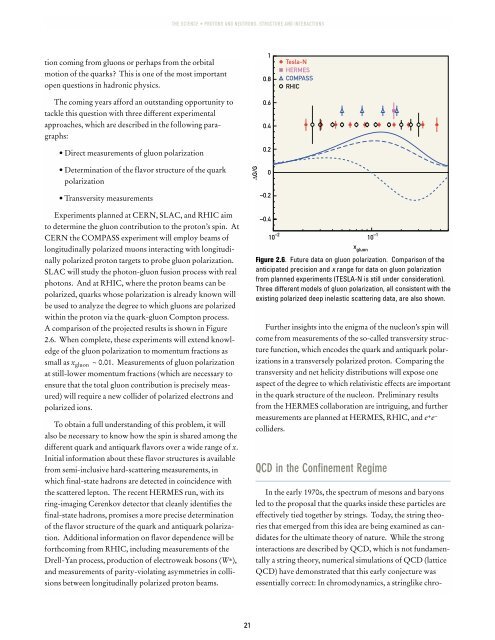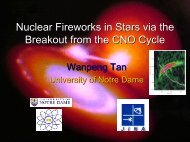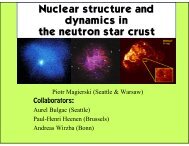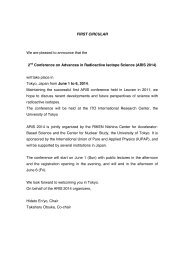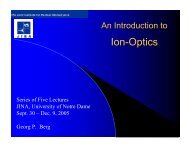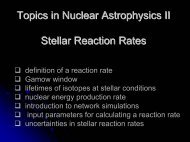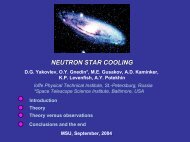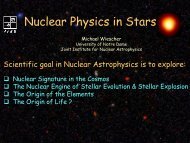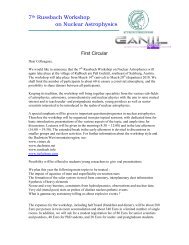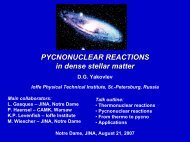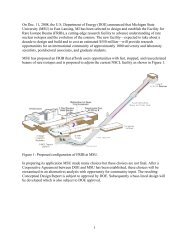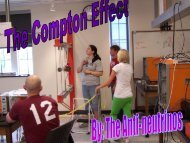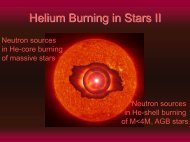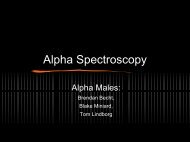OPPORTUNITIES IN NUCLEAR SCIENCE A Long-Range Plan for ...
OPPORTUNITIES IN NUCLEAR SCIENCE A Long-Range Plan for ...
OPPORTUNITIES IN NUCLEAR SCIENCE A Long-Range Plan for ...
You also want an ePaper? Increase the reach of your titles
YUMPU automatically turns print PDFs into web optimized ePapers that Google loves.
THE <strong>SCIENCE</strong> • PROTONS AND NEUTRONS: STRUCTURE AND <strong>IN</strong>TERACTIONS<br />
tion coming from gluons or perhaps from the orbital<br />
motion of the quarks? This is one of the most important<br />
open questions in hadronic physics.<br />
The coming years af<strong>for</strong>d an outstanding opportunity to<br />
tackle this question with three different experimental<br />
approaches, which are described in the following paragraphs:<br />
• Direct measurements of gluon polarization<br />
1<br />
0.8<br />
0.6<br />
0.4<br />
0.2<br />
Tesla-N<br />
HERMES<br />
COMPASS<br />
RHIC<br />
• Determination of the flavor structure of the quark<br />
polarization<br />
• Transversity measurements<br />
∆G/G<br />
0<br />
– 0.2<br />
Experiments planned at CERN, SLAC, and RHIC aim<br />
to determine the gluon contribution to the proton’s spin. At<br />
CERN the COMPASS experiment will employ beams of<br />
longitudinally polarized muons interacting with longitudinally<br />
polarized proton targets to probe gluon polarization.<br />
SLAC will study the photon-gluon fusion process with real<br />
photons. And at RHIC, where the proton beams can be<br />
polarized, quarks whose polarization is already known will<br />
be used to analyze the degree to which gluons are polarized<br />
within the proton via the quark-gluon Compton process.<br />
A comparison of the projected results is shown in Figure<br />
2.6. When complete, these experiments will extend knowledge<br />
of the gluon polarization to momentum fractions as<br />
small as x gluon ~ 0.01. Measurements of gluon polarization<br />
at still-lower momentum fractions (which are necessary to<br />
ensure that the total gluon contribution is precisely measured)<br />
will require a new collider of polarized electrons and<br />
polarized ions.<br />
To obtain a full understanding of this problem, it will<br />
also be necessary to know how the spin is shared among the<br />
different quark and antiquark flavors over a wide range of x.<br />
Initial in<strong>for</strong>mation about these flavor structures is available<br />
from semi-inclusive hard-scattering measurements, in<br />
which final-state hadrons are detected in coincidence with<br />
the scattered lepton. The recent HERMES run, with its<br />
ring-imaging Cerenkov detector that cleanly identifies the<br />
final-state hadrons, promises a more precise determination<br />
of the flavor structure of the quark and antiquark polarization.<br />
Additional in<strong>for</strong>mation on flavor dependence will be<br />
<strong>for</strong>thcoming from RHIC, including measurements of the<br />
Drell-Yan process, production of electroweak bosons (W ± ),<br />
and measurements of parity-violating asymmetries in collisions<br />
between longitudinally polarized proton beams.<br />
– 0.4<br />
10 – 2 10 – 1<br />
Further insights into the enigma of the nucleon’s spin will<br />
come from measurements of the so-called transversity structure<br />
function, which encodes the quark and antiquark polarizations<br />
in a transversely polarized proton. Comparing the<br />
transversity and net helicity distributions will expose one<br />
aspect of the degree to which relativistic effects are important<br />
in the quark structure of the nucleon. Preliminary results<br />
from the HERMES collaboration are intriguing, and further<br />
measurements are planned at HERMES, RHIC, and e + e –<br />
colliders.<br />
x gluon<br />
Figure 2.6. Future data on gluon polarization. Comparison of the<br />
anticipated precision and x range <strong>for</strong> data on gluon polarization<br />
from planned experiments (TESLA-N is still under consideration).<br />
Three different models of gluon polarization, all consistent with the<br />
existing polarized deep inelastic scattering data, are also shown.<br />
QCD in the Confinement Regime<br />
In the early 1970s, the spectrum of mesons and baryons<br />
led to the proposal that the quarks inside these particles are<br />
effectively tied together by strings. Today, the string theories<br />
that emerged from this idea are being examined as candidates<br />
<strong>for</strong> the ultimate theory of nature. While the strong<br />
interactions are described by QCD, which is not fundamentally<br />
a string theory, numerical simulations of QCD (lattice<br />
QCD) have demonstrated that this early conjecture was<br />
essentially correct: In chromodynamics, a stringlike chro-<br />
21


